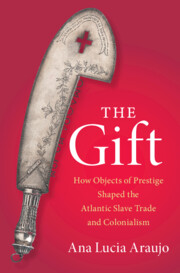Book contents
- The Gift
- Cambridge Studies on the African Diaspora
- The Gift
- Copyright page
- Contents
- Maps and Figures
- Maps
- Acknowledgments
- Introduction
- 1 The Loango Coast and the Rise of the Atlantic Slave Trade
- 2 La Rochelle and Atlantic Africa
- 3 Slave Traders Turned Pirates
- 4 Deciphering the Gift
- 5 A Displaced Gift
- 6 Ngoyo Meets Dahomey
- Conclusion
- Notes
- Bibliography
- Index
1 - The Loango Coast and the Rise of the Atlantic Slave Trade
Published online by Cambridge University Press: 26 October 2023
- The Gift
- Cambridge Studies on the African Diaspora
- The Gift
- Copyright page
- Contents
- Maps and Figures
- Maps
- Acknowledgments
- Introduction
- 1 The Loango Coast and the Rise of the Atlantic Slave Trade
- 2 La Rochelle and Atlantic Africa
- 3 Slave Traders Turned Pirates
- 4 Deciphering the Gift
- 5 A Displaced Gift
- 6 Ngoyo Meets Dahomey
- Conclusion
- Notes
- Bibliography
- Index
Summary
The kingdoms of Loango, Kakongo, and Ngoyo were highly centralized states, a feature that may have favored their persisting autonomy from the sixteenth to the nineteenth centuries. Unlike Luanda and Benguela, two Portuguese colonies, due to a variety of internal and external factors, not only the Portuguese, but also no other European power managed to ever control the three main ports of the Loango coast during the era of the Atlantic slave trade. As these three kingdoms of the Loango coast developed during the seventeenth century the initial European demand for commodities such as ivory and copper was gradually replaced with the commerce dealing in human beings during the second half of the seventeenth century. This chapter examines the history of the three kingdoms of the Loango coast. It explores how these states were structured, by identifying the main local agents involved in the trade with Europeans. It pays a particular attention to the role of the Mfuka in the Kingdom of Ngoyo in order to understand the complex interactions among African rulers, their local agents, and Portuguese, Dutch, British, and French slave merchants, who were often in competition.
- Type
- Chapter
- Information
- The GiftHow Objects of Prestige Shaped the Atlantic Slave Trade and Colonialism, pp. 11 - 28Publisher: Cambridge University PressPrint publication year: 2023



